Sanatan Articles
Satyaagrah
Written on
Satyaagrah
Written on
Satyaagrah
Written on
Satyaagrah
Written on
Satyaagrah
Written on
JOIN SATYAAGRAH SOCIAL MEDIA
Tipu Sultan remembered as killer of Brahmins and demolisher of temples in many villages of Tamil Nadu: a freedom fighter or Islamic bigot?

Tipu Sultan is often credited in our history textbooks as a ‘secular’ ruler of Mysore who fought against the British in the late 1700s. While the latter part of the sentence does hold merit, the former is nothing but blatant propaganda planted in History textbooks by the Congress party.
Tipu Sultan was one of the most ruthless Islamic invaders in South India. There have been several recorded instances of Tipu’s army forcefully converting, raping and kidnapping Hindus on his orders. Many temples are recorded to have been demolished under his reign. Historians such as Khan Hussain Ali Kirmani have pointed out that Tipu Sultan had animosity for the local Hindus and tribals in the area.
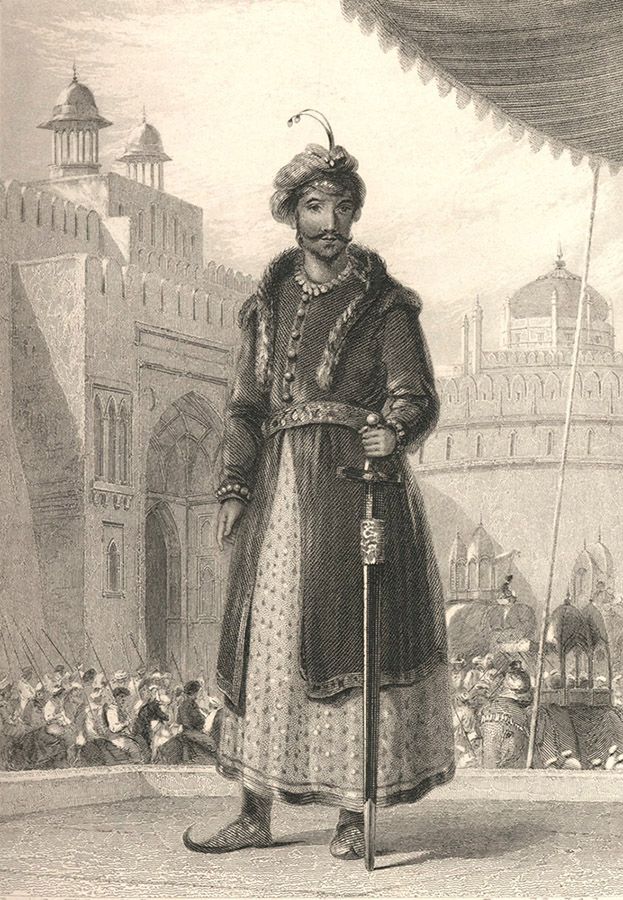 Portrait of Tippoo Saib - Tippu Sultan, ca. 1840 by John Cochran - royalacademy.org.uk |
Sita Ram Goel Introduction
Secularism per se is a doctrine which arose in the modern West as a revolt against the closed creed of Christianity. Its battle-cry was that the State should be freed from the stranglehold of the Church, and the citizen should be left to his own individual choice in matters of belief. And it met with great success in every Western democracy.
Had India borrowed this doctrine from the modern West, it would have meant a rejection of the closed creeds of Islam and Christianity, and a promotion of the Sanatana Dharma family of faiths which have been naturally secularist in the modern Western sense. But what happened actually was that Secularism in India became the greatest protector of closed creeds which had come here in the company of foreign invaders, and kept tormenting the national society for several centuries.
One can conclude quite safely that Nehruvian Secularism is a magic formula for transmitting base metals into twenty-four carat gold. How else do we explain the fact of Islam becoming a religion, and that too a religion of tolerance, social equality, and human brotherhood; or the fact of Muslim rule in medieval India becoming an indigenous dispensation; or the fact of Muhammad bin Qasim becoming a liberator of the toiling masses in Sindh; or the fact of Mahmud Ghaznavi becoming the defreezer of productive wealth hoarded in Hindu temples; or the fact of Muhammad Ghuri becoming the harbinger of an urban revolution; or the fact of Muinuddin Chishti becoming the great Indian saint; or the fact of Amir Khusru becoming the pioneer of communal amity; or the fact of Alauddin Khilji becoming the first socialist in the annals of this country; or the fact of Akbar becoming the father of Indian nationalism; or the fact of Aurangzeb becoming the benefactor of Hindu temples; or the fact of Sirajuddaula, Mir Qasim, Hyder Ali, Tipu Sultan, and Bahadur Shah Zafar becoming the heroes of India’s freedom struggle against British imperialism; or the fact of the Faraizis, the Wahabis, and the Moplahs becoming peasant revolutionaries and foremost freedom fighters?
One has only to go the original sources in order to understand the true character of Islam and its above-mentioned luminaries. And one can see immediately that their true character has nothing to do with that with which they have been invested in our school and college text-books. No deeper probe is needed for unraveling the mysteries of Nehruvian Secularism.
This is not the occasion to go into the implication of this Secularism vis-a-vis India’s own spiritual vision, India’s own cultural wealth, India’s own national society, and India’s own native nationalism. Suffice it to say that the other face of this Secularism is Hindu-baiting, which profession has been perfected by many scholars, scribes, and politicians, and has so far proved immensely profitable. There is no need to give out the names as the stalwarts in this field are very well known.
In the footsteps of his father
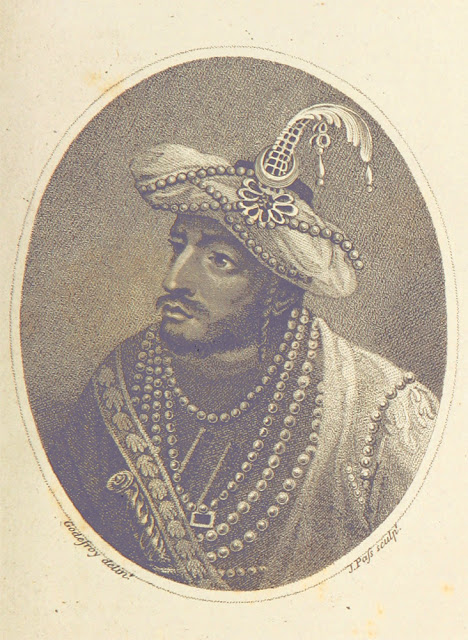 Portrait of Tipu Sultan in British Library |
The major part of Tipu Sultan’s rule was spent in conducting military operations for subjugating Malabar. Wars of territorial conquest waged in Malabar by Hyder Ali Khan, with the assistance of Ali Raja of Arackal and his Mappila followers of Cannanore, were intended more for spreading the Islamic faith by killing and forcible conversion of Hindus coupled with widespread destruction of Hindu temples, than for expanding his kingdom.
Hyder Ali Khan had expressed his satisfaction for these cruel achievements. A broad picture of atrocities committed against the Hindu population of Malabar by the army of Hyder Ali Khan along with the local Mappilas can be had from the diary notings of a Muslim officer of the Mysore army as edited and published by the then surviving son of Tipu Sultan, prince Ghulam Muhammed (Cited in Malabar Manual, William Logan).
Before his efforts to conquer the entire Malabar region could succeed, Hyder Ali Khan died in December, 1782. Tipu Sultan who succeeded his father, considered it his primary duty to continue this unfinished jihad started by Hyder Ali Khan. However, the Islamic fanaticism of Tipu Sultan was much worse than that of his father. His war-cry of jihad was “Sword” (death) or “Cap” (forcible conversion). This makes veiy clear the character of Tipu Sultan’s military operations started in 1783. The intensity and nature of sufferings which the Hindu population had to bear during the nightmarish days of Padayottakkalam (military regime) were vividly described in many historical records preserved in the royal houses of Zamorin and Kottayam (Pazhassi), Palghat Fort and East India Company’s office.
During the cruel days of Islamic operations from 1783 to 1791, thousands of Nairs besides about 30,000 Brahmins had fled Malabar, leaving behind their entire wealth, and sought refuge in Travancore State (according to the commission of enquiry appointed by the British soon after Tipu Sultan’s death).
This report was prepared exclusively for the information of the British authorities and not for writing a book, or for discrediting or defaming Tipu Sultan. Therefore, according to the learned historian, Dr. M. Gangadharan, there is no point in disbelieving the validity of this report ( Mathrubhoomi Weekly , January, 14-20, 1990): “Besides, there is enough evidence that a few members of Zamorin family and many Nairs were forcibly circumcised and converted into Muhammadan faith as well as compelled to eat beef.”
If one accepts even a small portion of the Islamic atrocities described in this monumental work of histoiy, then Tipu Sultan can be depicted only as fanatic Muslim bigot.
One of the leading Congressman of pre-independence days, K. Madhava Nair, observes on page 14 of his famous book, Malabar Kalapam (Mappila outrage):
“The communal Mappila outrage of 1921 in Malabar could be easily traced to the forcible mass conversion and related Islamic atrocities of Tipu Sultan during his cruel military regime from 1783 to 1792. It is doubtful whether the Hindus of Kerala had ever suffered so much devastation and atrocities since the reclamation of Kerala by the mythological Lord Parasurama in a previous Era. Many thousands of Hindus were forcibly converted into Muhammadan faith.”
In 1789, Tipu Sultan marched to Kozhikode with an army of 60,000, destroyed the fort, and razed the town to the ground Gunddart says in his Kerala Pazhama that it is just not possible to describe the cruel atrocities perpetrated by the barbarian Tipu Sultan in Kozhikode. William Logan gives in his Malabar Manual a long list of temples destroyed by Tipu Sultan and his army. Elankulam Kunjan Pillai has recorded the situation in Malabar as follows:
“Kozhikode was then a centre of Brahmins. There were around 7000 Namboodiri houses of which more than 2000 houses were destroyed by Tipu Sultan in Kozhikode alone. Sultan did not spare even children and women. Menfolk escaped to forests and neighbouring principalities. Mappilas increased many fold (due to forcible conversion)."
“During the military regime of Tipu Sultan, Hindus were forcibly circumcised and converted to Muhammadan faith. As a result the number of Nairs and Brahmins declined substantially.”
Religious intolerance of Tipu Sultan - Late P.C.N Raja Introduction
 Close-up of head and shoulders from full length portrait of Tipu Sahib (later Tipu Sultan) . 1780. Oil painting by John Zoffany (1733-1810). Tipu Sultan Museum |
Tipu Sultan had ruled his kingdom only for sixteen-and-a-half years, from December 7, 1782 to May 4, 1799. The territory of Malabar was under his effective control only for a short period of eight years.
When that Brahmin Prime Minister, Purnaiyya, presented to Tipu Sultan 90,000 soldiers, three crore rupees, and invaluable ornaments made of precious stones, he was tempted to rule as the Emperor of the South India. Tipu did not consider the Hindu rulers of Maharashtra, Coorg and Travancore or the Muslim ruler Nizam as impediments. He was afraid of only the British. He had convinced himself that he could easily become the Emperor of South India if he could somehow vanquish the British. Because of his intense anti-British attitude, the so-called progressive and secular historians have made a vain attempt to paint Tipu Sultan as a great national hero.
Opposition to foreign powers need not always be due to love for one’s countiy. To achieve his selfish goal and to face the British forces, Tipu Sultan sought the assistance of another foreign power, the French, who were manoeuvring to establish their own domination in the countiy. How is it possible, therefore, for Tipu Sultan to be an enemy of foreign forces when he himself had sought help from Napoleon who was then a prisoner in St. Helena Island and also the French King, Louis XVI?
Besides, he also wanted to establish Islamic rule in the countiy; to achieve that he had to first defeat the British. For this purpose, Tipu Sultan solicited the assistance of Muslim countries like Persia, Afghanistan and Turkey. It is true that Tipu did not harm the Raja of Cochin or anyone for that matter who surrendered and pledged loyalty to him. But how does that make him a friend of Hindus? Read more
Tipu's own testimony - C Nandagopal Menon
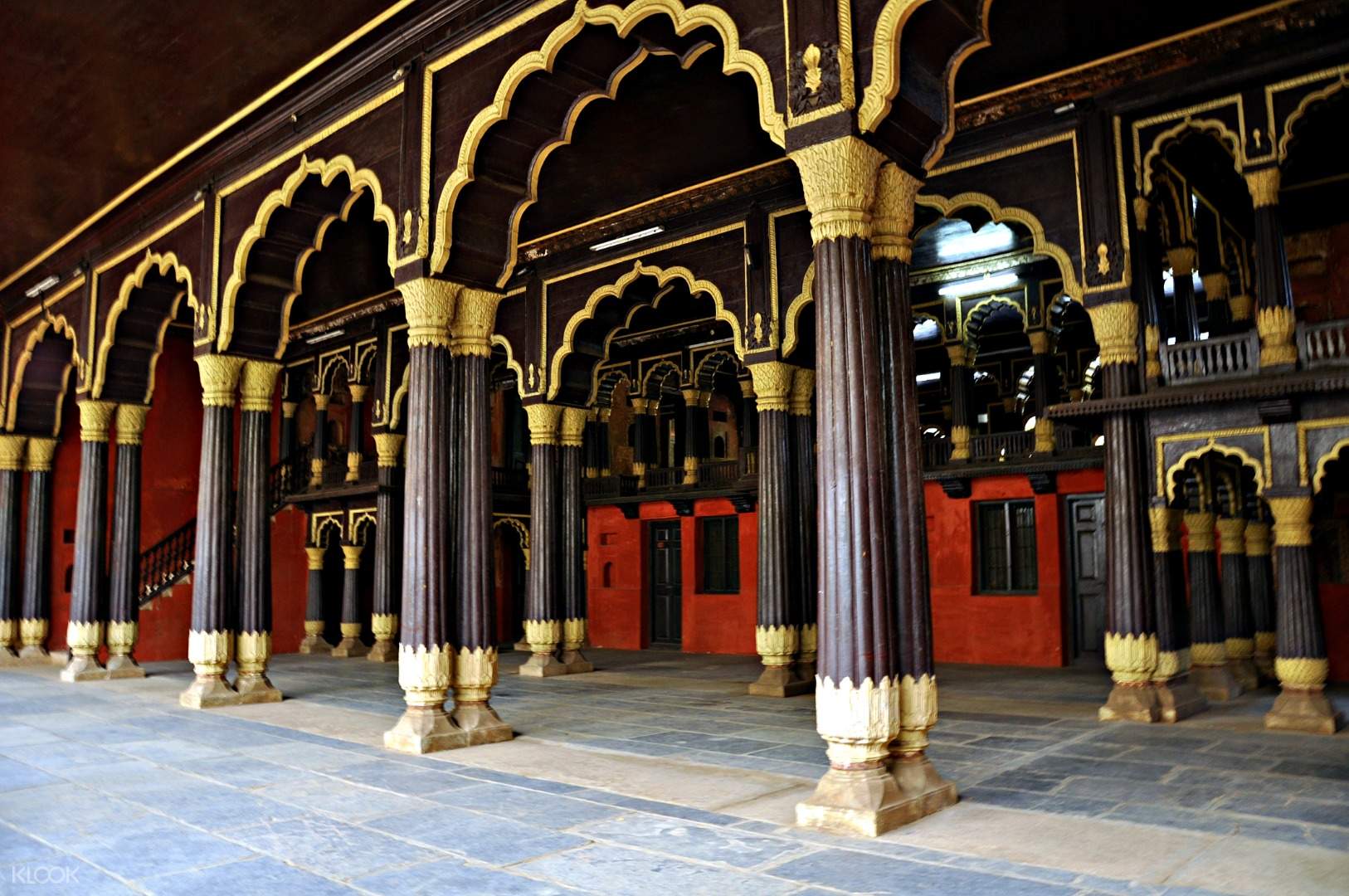 Palace of Tipu Sultan |
William Kirkpatrick, who compiled many of Tipu’s letters, writes in his book, Selected Letters of Tipoo Sultan (published in 1811): “Tipu knew his will to be a law the propriety of which... would never be questioned or doubted by any of his slaves... He probably measured the sentiments in question by a different standard from that with which we estimate them. Thus the various murders and acts of treachery which we see him directing to be carried into execution, were not criminal, but on the contrary just, and even meritorious, in his eyes.”
In his letter of January 19, 1790, which he sent to Budruz Zuman Khan it says: “Don’t you know I have achieved a great victory recently in Malabar and over four lakh Hindus were converted to Islam? I am determined to march against that cursed ‘Raman Nair’ veiy soon (reference is to Rama Varma Raja of Travancore State who was popularly known as Dharma Raja). Since I am overjoyed at the prospect of converting him and his subjects to Islam, I have happily abandoned the idea of going back to Srirangapatanam now” (K.M. Panicker, Bhasha Poshini , August, 1923).
In a letter dated January 18, 1790 to Syed Abdul Dulai, Tipu writes: “With the grace of Prophet Mohammed and Allah, almost all Hindus in Calicut are converted to Islam. Only on the borders of Cochin State a few are still not converted. I am determined to convert them also very soon. I consider this as Jehad to achieve that object” (K.M. Panicker, Bhasha Poshini). Read more
The renowned historian, Dr. I.M. Muthanna, says in his Tipu Sultan Xrayed that Tipu was a traitor as he invited the French to invade India. The letter, dated April 21, 1797, written by Tipu and classified as No. 4 in the Persian File of Records, and quoted by Muthanna in his book, reads:
“Citizen Representatives:
“Since I manifested my friendship in writing to you, my messengers have arrived with the following intelligence which will not be displeasing to you.
“The Nizam, an ally of the English, and the Chief of the Mughals, is very ill and his age leaves no prospect of his recoveiy. He has four children who are disputing the right of succession. One of them is much attached to me, (he) is the favourite of the chiefs of the people and is expected to succeed him.
“I inform these events in order to prove to you that it is now the moment for you to invade India. With little trouble we shall drive the British out of India. Rely on my friendship.
“Your ally (Sd) Tipu Sultan.”
That was Tipu’s expression of love for India!
The world-famous Protuguese traveler, Fr. Barthoelomeo, not a Britisher, writes in his book Voyage to East Indies-. “First a corps of 30,000 barbarians who butchered everybody on the way... Followed by the field-gun unit under the French Commander, M. Lally... Tipu was riding on an elephant behind which another army of 30,000 soldiers followed. Most of the men and women were hanged in Calicut, first mothers were hanged with their children tied to necks of
mothers. That barbarian Tipu Sultan tied the naked Christians and Hindus to the legs of elephants and made the elephants to move around till the bodies of the helpless victims were torn to pieces.
Temples and churches were ordered to be burned down, desecrated and destroyed. Christian and Hindu women were forced to marry Mohammadans and similarly their men were forced to marry Mohammadan women.
Faith in Astrology
V.R. Parameswaran Pillai writes in biography of the Diwan of Travancore, Life History of Raja Kesavadas: “Tipu had immense faith in astrological predictions. It was to become an Emperor (Padushah) after destroying the might of the British that Tipu resorted to land-grants and other donations to Hindu temples in Mysore including Sringeri Mutt, as per the advice of the local Brahmin astrologers. Most of these were done after his defeat in 1791 and the humiliating Srirangapatanam Treaty in 1792. These grants were not done out of respect or love for Hindus or Hindu religion but for becoming Padushah as predicted by the astrologers.”
Temples destroyed by Tipu
The Mysore Gazetteer says that the ravaging army of Tipu Sultan had destroyed more than 8000 temples in South India. The temples of Malabar and Cochin principalities had to bear the brunt of plunder and destruction. The History of Cochin by K.P. Padmanabha Menon and History of Kerala by A. Sreedhara Menon narrate some of them:
“In August, 186 Tipu’s Army destroyed idols of the famous Perumanam Temple and desecrated all the temples between Trichur and Kamvannur river. Irinjalakuda and Thiruvanchikulam temples were also defiled.
Some of the other famous temples looted and desecrated were as follows: Triprangot, Thrichembaram, Thirunavaya, Thiruvannoor, Calicut Thali, Hemambika Temple, the Jain Temple in Palghat, Mammiyur, Parambatali, Venkitangu, Pemmayanadu, Tiruvanjikulam, Terumanam, Vedakhumnnathan Temple of Trichur, Belur Siva Temple, Shri Veliyanattukava, Varakkal, Puthu, Govindapuram, Keraladhiswara, Trikkandiyur, Sukapuram, Maranehei Temple of Aaalvancheiri Tambrakkal, Vengara Temple of Aranadu, Tikulam, Ramanathakra, Azhinjalam Indiannur, Mannur Narayan Kanniar and Vadukunda Siva Temple of Madai. The Trikkavu Temple of Ponnani was converted into Military Garrison.
Tipu Sultan defeat and death
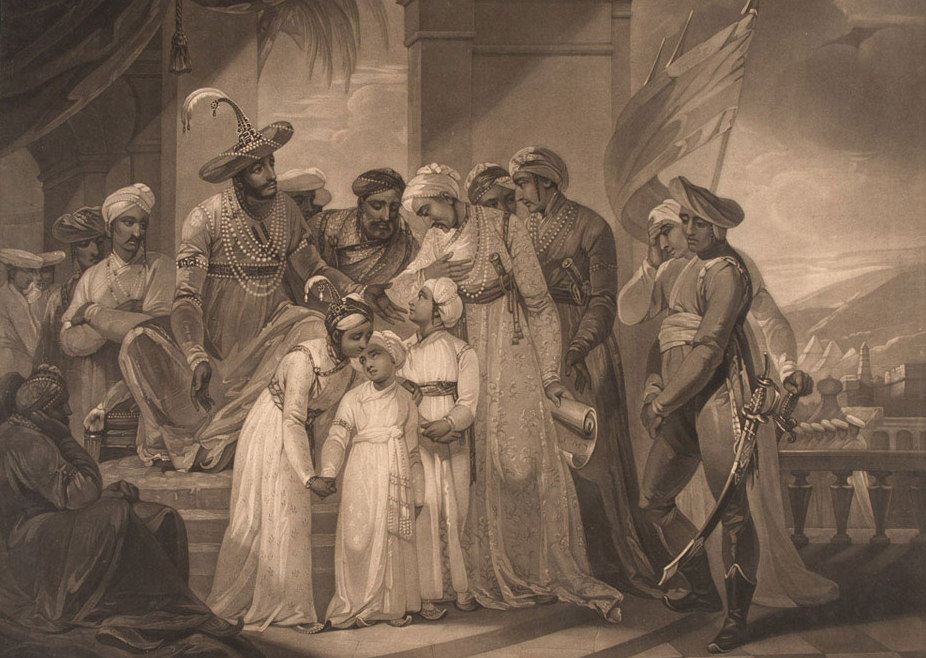 Tippoo Sultaun delivering to Gullumalli the Vakeel his two sons - A Lithograph by Joseph Grozer after Henry Singleton, published 10 August 1793 - National Army Museum |
He launched an attack against Travancore Raja but was defeated in January, 1790. According to Mr. Powney who was the Resident Representative of the English Company in Travancore, Tipu’s attack was not only effectively stopped by the Travancore army, Tipu himself fell down from the rampart, was seriously wounded, and was rendered permanently lame during the counter-attack by the Travancore forces.
That was the first time, January 1, 1790, when Tipu Sultan tasted a humiliating defeat. It is recorded in Travancore history.
According to authentic historical records, the Nair forces of Travancore attacked the Mysore army which was crossing the defence fortification, and inflicted heavy casualties on it. The sudden and unexpected attack made the Mysore Army panicky, and in the confusion Tipu Sultan fell down from the ramparts of the fort into the ditch below along with his palanquin. The fall made him permanently lame. Later on, the Travancore forces recovered from the ditch the sword, the pallanquin, the dagger, the ring and many other personal effects of Tipu and presented them to the Dharma Raja.
By the time Tipu Sultan launched his second attack and demolished parts of Nedungotta in May 1790, heavy monsoon rains caused the Alwaye river to flood the countryside. Since the Mysore army was not accustomed to fighting during rainy season, it was easy for the Travancore army to defeat Tipu’s army. That was the second defeat Tipu suffered near Alwaye in 1790.
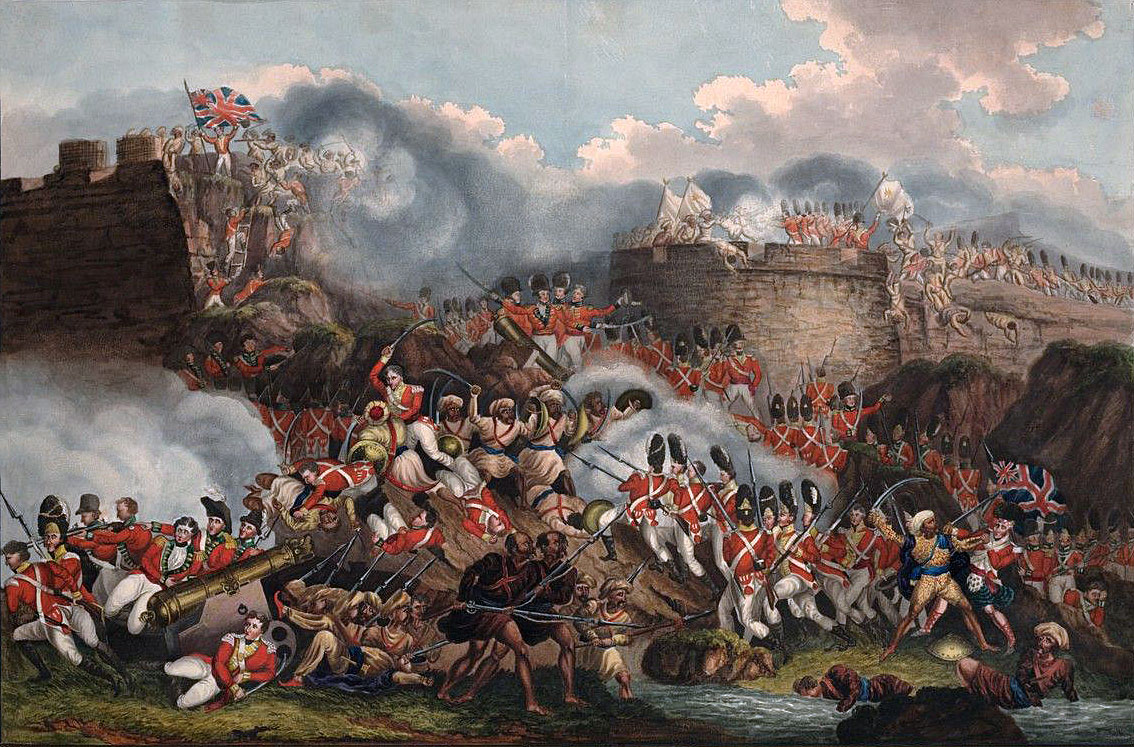 British 12th Regiment attacking the breach at the Storming of Seringapatam on 4th May 1799 in the Fourth Mysore War |
In the meantime, Lord Cornwallis, the Governor General, himself assumed the command of the British forces and pushed forward towards Srirangapatanam, headquarters of Tipu Sultan. Simultaneously, the Maratha and the Nizam’s forces also advanced from different directions. The final assault was mounted and Sriran gapatanam surrounded in January-February 1791 by a combined army consisting of the British, Maratha and the Nizam’s forces. Tipu Sultan, who rushed to Srirangapatanam, abandoning his military operations against Travancore, was forced to sign a treaty in 1792 ceding the entire West Coast and half of his other possessions to the Allies, thus relieving the Hindus of Kerala from further Islamic brutalities.
The death scene of Tipu Sultan in 1799 has been completely distorted in Gidwani’s infamous novel. He projects Tipu as a hero and a martyr. But as per recorded documents and official versions, Tipu, deserted by his generals and surrounded by the Allied forces, mounted a horse and tried to escape in the night like a coward. He was hit in the crossfire between his personal guards and the enemy forces, and fell down from the rampart in the midst of dead bodies of common soldiers. Later in the evening, a search was made for Tipu’s body with the help of torches. His body was finally recovered by one of his slaves and identified by the Khilledar ( Tipu Sultan X-rayed by Dr. I.M. Muthanna, p. 386).
National Insult
The period of Tipu Sultan and his father Hyder Ali Khan from 1766 to 1792 is the darkest period in Kerala history for all types of Islamic atrocities including forcible conversion. In spite of all these, historical documents and records are being deliberately suppressed, distorted and falsified in order to project this fanatic Tipu Sultan of Mysore as a liberal and magnanimous Muslim king.
To perpetuate the memoiy of this tyrant Tipu Sultan, the Central Government has released a postal stamp. Doordarshan has sanctioned a video serial to glorify the deeds and life of Tipu Sultan. And a special rehabilitation programme is being worked out for the benefit of the descendants of Tipu Sultan in Calcutta. It is an insult to our national pride and also to the Hindus of Kerala.
If such a notorious character is presented on the official network of Doordarshan as preaching patriotism, nationalism, high principles of Hindu religion, and human welfare, that is not only a national scandal but also a provocation for the Hindu community throughout the country. It is better to bury deep and forget the repulsive memories of Tipu Sultan and save the South from communal conflicts. The Hindus of Kerala who were the victims of the Islamic atrocities of Tipu Sultan, do not want to be reminded of him, just as the Jews do not want to be reminded of Hitler, or the Romanians of Ceasesescu, or the Russians of Stalin.
History of Legal Battle Against the TV Serial The Sword of Tipu Sultan – Madhavrao D. Pathak
The legal fight against the shameful and motivated attempt of Doordarshan and the Government of India to project the usurper king of Mysore, Tipu Sultan, as a national hero, was a long, expensive and frustrating ordeal. According to authentic and documented history of the period, Tipu Sultan had hanged to death and sold as slaves a large number of innocent men, women, and children; looted and destroyed and burnt down hundreds of Hindu temples and Christian churches; and circumcised and converted to Muhammadanism thousands of Hindus and Christians in Mangalore, Coorg, Coimbatore, Dindigal, and Kerala. He had made territorial concessions to the French whose help he sought to fight the British.
He had also sent emissaries to Islamic countries— Afghanistan, Iran, and Turky—inviting them to conquer the whole of North India for the glory and spread of Islam. But the Doordarshan serial on Tipu Sultan, based on a novel entitled The Sword of Tipu Sultan by Bhagwan Gidwani, was full of deliberate distortion, fabrication, and suppression of recorded facts of history with the object of glorifying a villain as a national hero, a benevolent ruler, and a paragon of all virtues. Read more
Don't Fabricate the History
Historical truth should not be allowed to be suppressed, or distorted, or falsified in order to project a national villain as a national hero. Today it is Tipu Sultan, tomorrow it will be Aurangzeb or Nadir Shah. If a renegade Indian glorifies the notorious Tipu Sultan today through a “historical novel”, tomorrow the same or some other motivated authors will produce more and better “historical novels” extolling Mahmud Ghaznavi, Malik Kafur, Aurangzeb, and Nadir Shah for a tele-serial. As Dr. I.M. Muthanna says in his famous book, Tipu Sultan X-rayed , “such dubious and mischievous historians and novelists should be prosecuted through judicial commissions so that at least in future such blatant lies and invented stories will not be sold or published as history or historical novels”. If in spite of the voluminous evidences to the contrary, the Doordarshan authorities agree to telecast anti-national and antiHindu serials on its official network, consequences will be terrible in the long run.
There was only one Aurangzeb and one Nadir Shah. And also one Tipu Sultan! Project them to the local people as known from authentic historical records. Otherwise the veiy purpose for which the official media of Radio and Doordarshan have been set up—to disseminate and present correct information and not lies and untruths—will be defeated.
Tipu Sultan’s reign ended when Mysore was defeated in the Anglo-Mysore wars, when the Marathas and Britishers squashed the brutal rule of Tipu Sultan.
There have been malicious attempts by Marxist and Islamist historians to make Tipu gain a ‘secular’ image in modern India, however such attempts have often been futile. Recently, when the Congress government of Karnataka tried to glorify this barbaric murderer, staunch opposition was seen in Coorg, where most of the barbaric acts were committed.
Even today, several villagers in Tamil Nadu call Tipu “killer of Brahmins and demolisher of temples”, in a bitter memory of his murderous regime.
 Support Us
Support Us
Satyagraha was born from the heart of our land, with an undying aim to unveil the true essence of Bharat. It seeks to illuminate the hidden tales of our valiant freedom fighters and the rich chronicles that haven't yet sung their complete melody in the mainstream.
While platforms like NDTV and 'The Wire' effortlessly garner funds under the banner of safeguarding democracy, we at Satyagraha walk a different path. Our strength and resonance come from you. In this journey to weave a stronger Bharat, every little contribution amplifies our voice. Let's come together, contribute as you can, and champion the true spirit of our nation.
 |  |  |
| ICICI Bank of Satyaagrah | Razorpay Bank of Satyaagrah | PayPal Bank of Satyaagrah - For International Payments |
If all above doesn't work, then try the LINK below:
Please share the article on other platforms
DISCLAIMER: The author is solely responsible for the views expressed in this article. The author carries the responsibility for citing and/or licensing of images utilized within the text. The website also frequently uses non-commercial images for representational purposes only in line with the article. We are not responsible for the authenticity of such images. If some images have a copyright issue, we request the person/entity to contact us at This email address is being protected from spambots. You need JavaScript enabled to view it. and we will take the necessary actions to resolve the issue.
Related Articles
- Supreme Court dismisses plea seeking protection of Hindus from the Muslim community in Mewat
- Hindus documented massacres for 1000s of years: Incomplete but indicative History of Attacks on India from 636 AD
- Prophecies of Jogendra Nath Mandal getting real after seventy years of his return from Pakistan
- The ‘Sanghi propaganda’ trope on abduction and conversion of Sikh girls to Islam. Here is how this online tirade is an omen of impending danger
- Twitter rewards an Islamist org, set to be banned by India, with a verified blue tick: Here is what PFI has done in the past
- On 16th Aug 1946, during Ramzan's 18th day, Direct Action Day aimed to provoke Muslims by mirroring Prophet Muhammad's victory at Badr, Gopal 'Patha', the Lion of Bengal, heroically saved Bengali Hindus & Calcutta from a planned genocide, altering history
- Direct Action Day triggers The Great Calcutta Killings: Kolkata Paid Its Lives To Create Pakistan
- Why Hindu-Sikh genocide of Mirpur in 1947 ignored? Why inhuman crimes of Radical Islamists always hidden in India?
- "Hinduon ke beech me khade hoke namaaz padi, that was very very special for me" - Waqar Younis takes Jihadist mindset of another level
- UP mass conversion: How Darsh Saxena, Rajeshwari and Priyanka became Mohd Rehaan Ansari, Razia and Fatima, more details emerge
- Islamists are raging Land Jihad by encroaching iconic Maharashtra forts through illegal constructions within the premises, falsifying history by inventing fictional characters
- Narasimha Rao govt brought places of Worship Act as a hurdle in reclaiming ancient Hindu heritage destroyed by Muslim invaders
- Hitler’s propaganda minister Joseph Goebbels said 'Repeat a lie often enough and it becomes the truth' - Whitewashing a genocide – how the exodus of Kashmiri Pandits is being blamed on Hindus instead of on Islamists
- Telegram channel using images of Hindu women for harassment and abuse is blocked: IT Minister Ashwini Vaishnaw orders action against Channel, Mumbai Police keeps mum
- ‘Go to haram restaurants and poison their food’: Ex-Australian ISIS bride now lives a free life in Turkey. Details





















